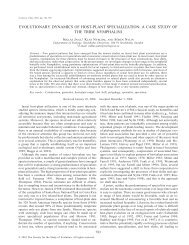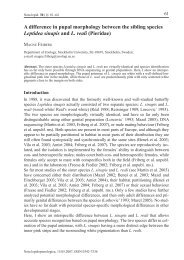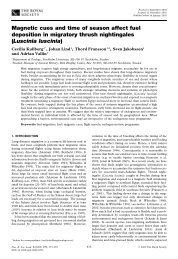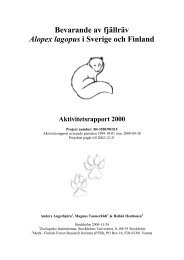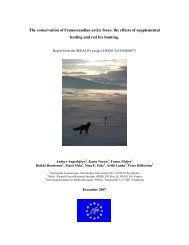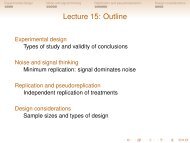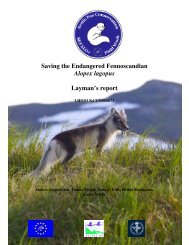Evolution of Fighting Behaviour: The Effect of Variation in Resource ...
Evolution of Fighting Behaviour: The Effect of Variation in Resource ...
Evolution of Fighting Behaviour: The Effect of Variation in Resource ...
Create successful ePaper yourself
Turn your PDF publications into a flip-book with our unique Google optimized e-Paper software.
198M. ENQUIST AND O. LEIMARII10/~5~ZC t I0-5 1 1.5<strong>Resource</strong> volueFIG. 6. Expected fight duration as a function <strong>of</strong> resource value for the ESS for the owner-<strong>in</strong>trudergame with an <strong>in</strong>formation asymmetry shown <strong>in</strong> Fig. 3. Curve 1 refers to fights won by the <strong>in</strong>truder, curve2 to all fights, and curve 3 to fights won by the owner.be 1.0 both for owners and <strong>in</strong>truders) we obta<strong>in</strong> a situation with an uncorrelatedrole asymmetry. Intuitively, it would seem that such a situation is less asymmetricand more favourable to <strong>in</strong>truders than when owners are more <strong>in</strong>formed about theresource. However, compar<strong>in</strong>g the owner's probability <strong>of</strong> w<strong>in</strong>n<strong>in</strong>g and overall utilitybetween the <strong>in</strong>formation asymmetric case studied here and the situation with anuncorrelated role asymmetry studied <strong>in</strong> Leimar & Enquist (1984), one obta<strong>in</strong>s thatthe owner has a higher probability w<strong>in</strong>n<strong>in</strong>g and a higher utility with the ESS forthe uncorrelated role asymmetry. This <strong>in</strong>dicates that <strong>in</strong>formation asymmetry per sehas a rather small importance when it comes to expla<strong>in</strong><strong>in</strong>g why <strong>in</strong> nature ownerstend to w<strong>in</strong> most owner-<strong>in</strong>truder <strong>in</strong>teractions. It also shows that <strong>in</strong>tuition cansometimes be a poor guide to the solution <strong>of</strong> game theory problems.Comparison With Empirical Data<strong>Effect</strong>s <strong>of</strong> resource value on contest behaviour have been demonstrated <strong>in</strong> severalstudies, and we now discuss to what extent results from such studies are <strong>in</strong> agreementwith predictions from game theory. <strong>The</strong> behavioural parameters usually analysed<strong>in</strong> relation to variation <strong>in</strong> resource value are fight duration, frequencies <strong>of</strong> variousbehaviour patterns, and, <strong>in</strong> asymmetrical situations probability <strong>of</strong> victory. <strong>The</strong> datawe have found <strong>in</strong> the literature on relationships between these variables and resourcevalue are summarized <strong>in</strong> Table 1.In those studies where they have been analysed, both fight duration and thefrequency <strong>of</strong> potentially dangerous behaviour patterns (<strong>of</strong>fensive behaviour <strong>in</strong> Table1) <strong>in</strong>crease when resource value <strong>in</strong>creases. <strong>The</strong> cost <strong>of</strong> fight<strong>in</strong>g has been measureddirectly <strong>in</strong> a study <strong>of</strong> male bowl and doily spiders compet<strong>in</strong>g for females (Austad,1983). <strong>The</strong> cost was estimated as the relative frequency <strong>of</strong> fatal <strong>in</strong>juries, and wasshown to <strong>in</strong>crease with the value <strong>of</strong> the female. <strong>The</strong> results on fight duration anduse <strong>of</strong> <strong>of</strong>fensive behaviour patterns <strong>in</strong> Table 1 also suggest that the cost <strong>of</strong> fight<strong>in</strong>g



